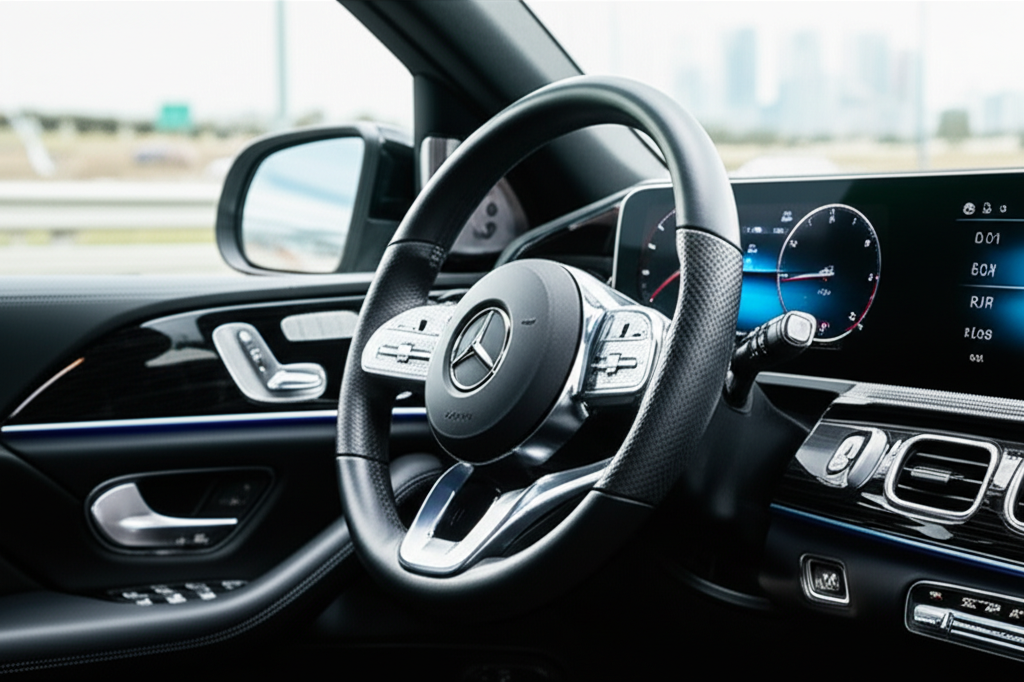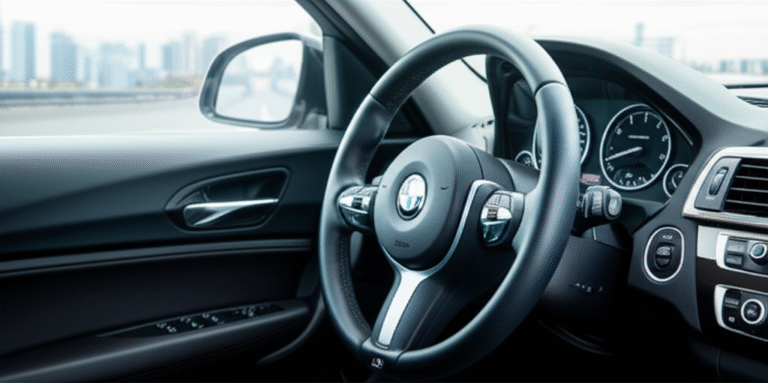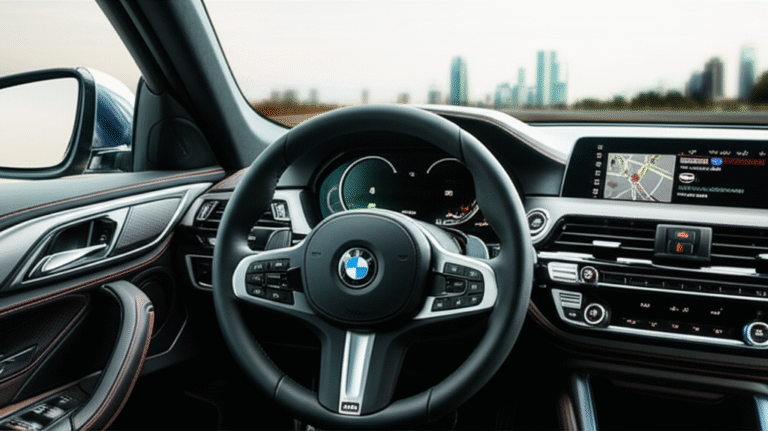Mercedes GLS vs BMW X7: 6 Comparison Facts

Comparing the Mercedes GLS vs BMW X7 reveals two titans of the luxury SUV segment. Both offer opulent interiors, potent performance, and advanced technology, but they cater to slightly different preferences. Understanding their core differences is key to choosing the perfect vehicle for your needs.
Key Takeaways
- Discover six critical comparison points for the Mercedes GLS and BMW X7.
- Evaluate performance, interior luxury, and technology for both SUVs.
- Understand seating capacity and cargo space differences.
- Learn about safety features and driver-assist systems.
- Compare infotainment and connectivity options.
- Make an informed decision based on your lifestyle and priorities.
When you’re looking for a full-size luxury SUV in the USA, two names often rise to the top: the Mercedes-Benz GLS and the BMW X7. These vehicles represent the pinnacle of what these iconic German automakers offer in terms of space, comfort, and cutting-edge technology. Navigating the nuances between them can feel like a challenge, especially with so many impressive features packed into each. You want to make sure you’re choosing the SUV that best fits your lifestyle and driving needs. This guide breaks down six key comparison facts between the Mercedes GLS and BMW X7, making it easier for you to decide which one is your perfect match.
Understanding the Luxury SUV Landscape in the USA
The luxury SUV market in the United States is a vibrant and competitive space. For decades, American drivers have gravitated towards vehicles that offer the versatility of an SUV with the refinement and features of a luxury sedan. German automakers, particularly Mercedes-Benz and BMW, have consistently led this charge, pushing the boundaries of innovation, performance, and passenger comfort. The GLS and X7 are their flagship offerings in this segment, designed to compete directly with each other and appeal to families and individuals who demand the very best.
These large luxury SUVs are more than just transportation; they are statements of success and a gateway to unparalleled comfort and advanced automotive engineering. Whether you’re navigating the bustling streets of New York City, embarking on a cross-country road trip, or simply enjoying your daily commute in Los Angeles, the GLS and X7 promise an exceptional experience. We’ll delve into the specific areas where these two behemoths differ, empowering you with the knowledge to make a confident choice.
1. Performance and Powertrain Options: Horsepower Wars
Under the hood, both the Mercedes GLS and BMW X7 offer potent powertrains designed to deliver robust performance without sacrificing refinement. This is where the “driving dynamics” of each brand truly shine, and the differences can significantly impact your driving experience.
Mercedes-Benz GLS Powertrains
The Mercedes-Benz GLS typically comes with a range of powerful engine options. For many model years, the GLS 450 is equipped with a turbocharged inline-six engine that’s augmented by a mild-hybrid system. This system, known as EQ Boost, provides a temporary surge of power and smoother acceleration, especially from a standstill. It also aids in fuel efficiency. For those seeking even more power, the GLS 580 often features a twin-turbocharged V8 engine, also with the EQ Boost mild-hybrid system, delivering exhilarating acceleration and a commanding presence on the road. All GLS models come with Mercedes-Benz’s renowned 9-speed automatic transmission and the 4MATIC all-wheel-drive system, ensuring confident handling in various conditions.
BMW X7 Powertrains
BMW’s approach to performance in the X7 emphasizes its “Ultimate Driving Machine” heritage. The X7 typically starts with a potent turbocharged inline-six engine in the xDrive40i model, offering a great balance of power and efficiency. Stepping up, the M60i (formerly M50i) variant boasts a formidable twin-turbocharged V8 engine that provides serious acceleration and a more aggressive exhaust note, truly embodying the M performance spirit. The Alpina XB7, a high-performance variant, takes this even further with exclusive tuning. All X7 models are paired with an 8-speed Steptronic Sport automatic transmission and BMW’s xDrive all-wheel-drive system, which can intelligently distribute power to optimize traction and handling.
Performance Comparison Table
| Feature | Mercedes-Benz GLS | BMW X7 |
|---|---|---|
| Base Engine | 3.0L Inline-6 Turbo with EQ Boost (Mild-Hybrid) | 3.0L Inline-6 Turbo (Gasoline) |
| Optional High-Performance Engine | 4.0L V8 Twin-Turbo with EQ Boost (Mild-Hybrid) | 4.4L V8 Twin-Turbo (M60i) / Alpina-tuned V8 |
| Transmission | 9-Speed Automatic | 8-Speed Steptronic Sport Automatic |
| Drivetrain | 4MATIC All-Wheel Drive | xDrive All-Wheel Drive |
| Driving Character | Smooth, refined, effortless power, comfortable | Engaging, sporty, responsive, dynamic |
While both offer strong V8 options, the GLS often feels a bit more focused on effortless cruising, with its mild-hybrid system smoothing out power delivery. The X7, especially in its M-tuned variants, leans more towards a driver-focused experience, with sharper throttle response and a more dynamic feel. New car shoppers in the US can visit official manufacturer websites like Mercedes-Benz USA and BMW USA for the most current engine specifications.
2. Interior Design and Luxury: A Feast for the Senses
Stepping inside these premium SUVs is an experience in itself. Both Mercedes-Benz and BMW are renowned for their luxurious cabins, high-quality materials, and meticulous craftsmanship. The GLS and X7 represent the zenith of this philosophy, offering spaces that are both technologically advanced and incredibly comfortable.
Mercedes-Benz GLS Interior
The Mercedes-Benz GLS interior is often described as a “S-Class of SUVs.” It exudes an air of sophistication and opulence. Expect plush leather upholstery, real wood trim, and ambient lighting that can be customized to your mood. The dashboard design is elegant, featuring a prominent, integrated display that houses both the instrument cluster and the infotainment system. Mercedes-Benz places a strong emphasis on comfort, with exceptionally supportive and often multi-contour seats that can offer heating, ventilation, and even massage functions. The cabin is exceptionally quiet, thanks to superior sound insulation, making it a tranquil sanctuary on wheels.
BMW X7 Interior
The BMW X7 interior is equally luxurious but tends to have a slightly sportier and more driver-centric feel. While it uses equally high-quality materials – think premium leather, open-pore wood options, and brushed metal accents – the design is often more angular and modern. The iDrive infotainment system’s screen is prominent, as is the digital driver display. BMW focuses on creating an ergonomic and intuitive environment for the driver. The seats are supportive and comfortable for long journeys, and the overall ambiance is one of sophisticated technology. The X7’s design might appeal more to those who appreciate a blend of luxury and a hint of sporty aggression.
Interior Amenities Comparison
| Feature | Mercedes-Benz GLS | BMW X7 |
|---|---|---|
| Upholstery Options | Premium Leather, Nappa Leather | Vernasca Leather, Nappa Leather |
| Trim Options | Various Wood types (e.g., Walnut, Piano Lacquer), Metal | Open-pore Wood, Piano Black, Fine Brushed Aluminum |
| Ambient Lighting | Extensive, customizable multi-zone lighting | Advanced, customizable ambient lighting |
| Seating Features | Multi-contour seats, massage, heating, ventilation | Multi-contour seats, massage, heating, ventilation |
| Overall Ambiance | Opulent, serene, S-Class inspired comfort | Sporty luxury, modern, driver-focused |
Both vehicles excel in creating a premium environment. The choice often comes down to personal aesthetic preference: do you prefer the more classic, opulent luxury of the GLS, or the more contemporary, driver-oriented luxury of the X7? For definitive interior specifications and customization options, exploring the build-and-price tools on Mercedes-Benz USA and BMW USA is highly recommended.
3. Seating and Cargo Space: Practicality Meets Plushness
One of the primary reasons for choosing a full-size luxury SUV is the need for ample space. Both the Mercedes GLS and BMW X7 are designed with families and those who need to transport multiple passengers or significant cargo in mind. They offer three rows of seating, but the execution and usability can differ.
Seating Capacity and Comfort
Both the GLS and X7 typically seat up to seven passengers as standard, with captain’s chairs in the second row. An optional second-row bench seat can increase capacity to eight passengers in some configurations. The third row in both SUVs is generally suitable for children or adults on shorter trips, though they offer more legroom than in smaller SUVs. Mercedes-Benz often boasts a slight edge in third-row legroom and overall ease of access, making it a slightly more practical choice for regularly carrying adults in the rearmost seats. The power-folding second and third-row seats in both vehicles make reconfiguring the interior for cargo a breeze.
Cargo Dimensions and Flexibility
When it comes to cargo space, both are highly capable. The total cargo volume behind the first row is substantial in both models, easily accommodating large loads for road trips or shopping sprees. However, the usable space behind the third row is often a crucial deciding factor for families. The GLS has historically offered a bit more cargo volume when all seats are in use compared to the X7. Conversely, when the third row is folded flat, the X7 can offer a very generous and flat load floor, which is excellent for bulky items. The power-folding third rows in both are a significant convenience for reconfiguring your interior on the fly.
Space Comparison Table
| Feature | Mercedes-Benz GLS | BMW X7 |
|---|---|---|
| Standard Seating | 7 Passengers (2+2+3) | 7 Passengers (2+2+3) |
| Optional Seating | Bench Second Row for 8 Passengers | Bench Second Row for 8 Passengers |
| Third-Row Passenger Space | Good, slightly more legroom | Good, adult-friendly for shorter trips |
| Cargo Space (Behind 3rd Row) | Approximately 10-12 cubic feet | Approximately 8-10 cubic feet |
| Cargo Space (Behind 2nd Row) | Approximately 38-42 cubic feet | Approximately 32-35 cubic feet |
| Max Cargo Space (Seats Folded) | Approximately 80-85 cubic feet | Approximately 75-80 cubic feet |
For those who frequently use all three rows and need maximum cargo space behind the third row, the GLS might hold a slight advantage. If you prioritize a flat load floor when the third row is down and are less concerned with maximizing space behind the last row, the X7 is still an excellent choice. For detailed dimensions, always refer to the official specifications on the manufacturer’s websites.
4. Technology and Infotainment: Staying Connected and Informed
In the realm of luxury vehicles, technology plays a crucial role. Both the Mercedes GLS and BMW X7 are packed with the latest infotainment systems, driver aids, and connectivity features, designed to enhance convenience, safety, and the overall driving experience. The interfaces and philosophies behind their tech can differ, though.
Mercedes-Benz GLS Technology
The Mercedes-Benz GLS features the MBUX (Mercedes-Benz User Experience) infotainment system. This system is known for its intuitive voice control, powerful natural language processing (you can say “Hey Mercedes, I’m cold” to adjust the temperature), and slick graphical interface. The large, widescreen cockpit display can be customized with various themes and information layouts. Apple CarPlay and Android Auto integration are standard. The GLS also offers an impressive array of driver-assistance systems, including adaptive cruise control with steering assist, lane-keeping assist, and parking assist, often grouped under Mercedes PRO-S (Driver Assistance Package).
BMW X7 Technology
The BMW X7 utilizes the iDrive infotainment system, which is a long-standing benchmark for usability in the industry. In its latest iterations, iDrive is controlled via a crisp touchscreen, a rotary dial on the center console, voice commands, and steering wheel controls. It offers seamless integration with Apple CarPlay and Android Auto. BMW’s ConnectedDrive services provide a suite of features like remote access via a smartphone app, real-time traffic information, and concierge services. The X7 also comes equipped with a comprehensive suite of advanced driver-assistance systems, including similar features to the GLS covering adaptive cruise control, steering, lane centering, and more, typically found within packages like the Driving Assistance Professional Package.
Technology Comparison Table
| Feature | Mercedes-Benz GLS | BMW X7 |
|---|---|---|
| Infotainment System | MBUX (Mercedes-Benz User Experience) | iDrive System |
| Primary Control Methods | Touchscreen, Voice, Steering Wheel Buttons | Touchscreen, Rotary Dial, Voice, Steering Wheel Buttons |
| Voice Assistant | “Hey Mercedes” (Natural Language Processing) | “Hey BMW” (Enhanced voice commands) |
| Smartphone Integration | Apple CarPlay, Android Auto | Apple CarPlay, Android Auto |
| Driver Assistance Suite | PRO-S (Driver Assistance Package) | Driving Assistance Professional Package |
| Available Features | Augmented reality navigation, Head-up display, advanced parking assist | Gesture Control, Head-up display, advanced parking assist |
Both systems are incredibly advanced and user-friendly. The MBUX system in the GLS might feel slightly more futuristic with its AI-powered voice assistant. BMW’s iDrive, particularly with the physical rotary dial, is often preferred by drivers who like tactile feedback and a more traditional way to navigate menus. The availability of features like gesture control in the X7 (on select models/packages) adds another layer of technological flair. For detailed feature lists, consult the official specification sheets from Mercedes-Benz USA and BMW USA.
5. Safety Features and Driver Assistance: Peace of Mind on the Road
When you’re behind the wheel of a large luxury SUV, especially one that will carry your family, safety is paramount. Mercedes-Benz and BMW have long been pioneers in automotive safety, and their flagship SUVs are equipped with an extensive array of passive and active safety features.
Mercedes-Benz GLS Safety Innovations
The Mercedes-Benz GLS comes standard with a comprehensive suite of safety features, including multiple airbags, stability control, and a rearview camera. Beyond these basics, it offers sophisticated driver-assistance systems that go a long way in preventing accidents. These often include:
- Active Brake Assist: Can automatically apply brakes if it detects an impending collision.
- ATTENTION ASSIST®: Monitors the driver for signs of fatigue.
- Blind Spot Assist: Warns of vehicles in your blind spots.
- Lane Keeping Assist: Helps keep the vehicle centered in its lane.
- Adaptive Cruise Control with Steering Assist: Maintains a set distance from the car ahead and can help steer.
The GLS consistently earns high safety ratings from organizations like the National Highway Traffic Safety Administration (NHTSA) and the Insurance Institute for Highway Safety (IIHS), reflecting its robust safety engineering.
BMW X7 Safety Innovations
Similarly, the BMW X7 is engineered with safety at its core. Standard features include a full complement of airbags, dynamic stability control, and parking sensors. The available advanced driver-assistance technologies aim to make driving safer and less stressful:
- Active Cruise Control with Stop & Go: Maintains speed and distance, and can bring the vehicle to a complete stop.
- Lane Departure Warning: Alerts the driver if the vehicle drifts out of its lane.
- Active Blind Spot Detection: Provides warnings and can intervene if necessary.
- Frontal Collision Warning with City Collision Mitigation: Detects potential frontal collisions and can initiate braking.
- Cross-Traffic Alert: Warns of approaching traffic when reversing.
The X7 also typically achieves excellent safety scores from NHTSA and IIHS, underscoring its commitment to occupant protection.
Safety Technology Overview
| System | Mercedes-Benz GLS | BMW X7 |
|---|---|---|
| Adaptive Cruise Control | Standard/Available (often with enhanced features) | Standard/Available (often with enhanced features) |
| Lane Keeping/Departure Warning | Standard/Available | Standard/Available |
| Blind Spot Monitoring | Standard/Available | Standard/Available |
| Automatic Emergency Braking | Standard/Available | Standard/Available |
| Forward Collision Warning | Standard/Available | Standard/Available |
| Parking Assistance | Available | Available |
Both manufacturers offer highly advanced safety suites. The specific features and whether they are standard or optional can vary by model year and trim level. It’s always wise to check the most current safety feature list for the specific vehicle you are considering. For official safety ratings, visit NHTSA’s and IIHS’s websites.
6. Driving Dynamics and Ride Comfort: Two Philosophies
The driving experience is where the distinct personalities of the Mercedes-Benz GLS and BMW X7 truly emerge. While both are large, luxurious SUVs, their engineering priorities lead to different sensations behind the wheel.
Mercedes-Benz GLS Driving Experience
The Mercedes-Benz GLS is engineered for supreme comfort and a serene driving experience. Its suspension system, often featuring adaptive damping or even optional active suspension (like E-ACTIVE BODY CONTROL in certain models), is adept at smoothing out road imperfections, providing a ride that feels exceptionally plush and isolated from the road. The steering is typically light and precise, encouraging relaxed cruising. While it’s a large SUV, the GLS feels stable and planted, making long journeys feel effortless. It prioritizes a smooth, quiet, and refined ride, enveloping occupants in a cocoon of comfort.
BMW X7 Driving Experience
BMW’s philosophy for the X7 centers on delivering a more engaging and dynamic driving experience, even in a large luxury SUV. The suspension, while still providing excellent comfort, is tuned to feel more responsive and connected to the road. The steering is often a bit more direct and communicative than the GLS, giving the driver a better sense of the road surface and tire grip. The X7 feels remarkably agile for its size, with less body roll in corners than one might expect. This makes it a more involving and sporty choice for those who enjoy the act of driving.
Ride and Handling Comparison
| Aspect | Mercedes-Benz GLS | BMW X7 |
|---|---|---|
| Primary Focus | Comfort, refinement, serene ride | Engaging drive, sporty handling, driver feedback |
| Suspension | Comfort-biased, often adaptive or active for superior ride quality | Balanced comfort and sportiness, responsive tuning |
| Steering | Light, smooth, less feedback | More direct, communicative, better road feel |
| Handling in Corners | Stable, composed, minimal body roll for its size | Agile for its size, confident cornering, less body roll |
| Noise Insulation | Exceptional, very quiet cabin | Excellent, but can have a sportier exhaust note |
Pro Tip: When test driving both vehicles, pay close attention to the suspension settings. Many models allow you to select different drive modes (e.g., Comfort, Sport) that significantly alter the ride and handling characteristics, giving you a taste of both worlds.
Ultimately, the choice between the GLS and X7 in terms of driving dynamics comes down to personal preference. If your priority is a supremely comfortable, quiet, and effortless ride, the Mercedes-Benz GLS is likely the better fit. If you prefer a more connected, engaging, and sporty driving experience in your large SUV, the BMW X7 will probably appeal more.
Frequently Asked Questions (FAQs)
What is the biggest difference between the Mercedes GLS and BMW X7?
The biggest difference lies in their driving philosophy and interior ambiance. The Mercedes GLS prioritizes unparalleled comfort, a serene ride, and opulent luxury, akin to a luxury sedan. The BMW X7 balances luxury with a sportier, more engaging driving dynamic and a modern, driver-focused interior.
Which SUV is better for families, the GLS or X7?
Both are excellent family SUVs. The GLS might have a slight edge for families who frequently use all three rows, as it often offers marginally more third-row legroom and cargo space behind the third row. However, both provide ample space and versatile seating configurations for most families.
Are the V8 engines in the GLS and X7 worth the extra cost?
For most drivers, the standard inline-six engines in both the GLS and X7 offer more than enough power for daily driving and confident highway merging. The V8 engines provide significantly more acceleration and towing capability, making them ideal for those who need extreme power or tow heavy loads. They also add to the distinct character of the vehicles but come with a higher price tag and increased fuel consumption.
Which luxury SUV has better technology features?
Both vehicles are packed with cutting-edge technology. The choice between Mercedes’ MBUX and BMW’s iDrive often comes down to personal preference. MBUX is known for its advanced voice control and AI capabilities, while iDrive is praised for its logical layout and the combination of touchscreen and rotary dial control.
Is the Mercedes GLS or BMW X7 more reliable?
Both Mercedes-Benz and BMW are premium brands that generally offer good reliability, but specific model years and configurations can vary. It’s always recommended to check reliability ratings from sources like Consumer Reports or J.D. Power for the specific model year you are considering. Regular maintenance according to the manufacturer’s schedule is crucial for both.
Which SUV holds its value better?
Historically, both Mercedes-Benz and BMW models tend to hold their value well within the luxury segment. Depreciation can vary based on mileage, condition, trim level, and market demand for specific model years. It’s beneficial to research historical resale values for specific GLS and X7 models on automotive valuation websites.
Conclusion
Choosing between the Mercedes-Benz GLS and the BMW X7 is a delightful dilemma, as both represent the pinnacle of full-size luxury SUV engineering from two of the world’s leading automakers. The Mercedes GLS stands out as the ultimate chariot of comfort, offering a serene and opulent cabin that rivals its sedan counterparts, coupled with a smooth, effortless driving experience. It’s the ideal choice if your priorities are supreme ride quality, a tranquil interior, and a touch of classic luxury.
On the other hand, the BMW X7 appeals to those who seek a more dynamic and engaging driving feel without sacrificing luxurious appointments or practicality. Its sporty handling, driver-focused cockpit, and modern aesthetic make it a compelling option for those who enjoy the act of driving and appreciate a blend of performance and refinement. Ultimately, the best way to decide is to experience both firsthand. A test drive in each will reveal which SUV’s unique blend of luxury, performance, and technology best aligns with your personal preferences and your life here in the USA.






